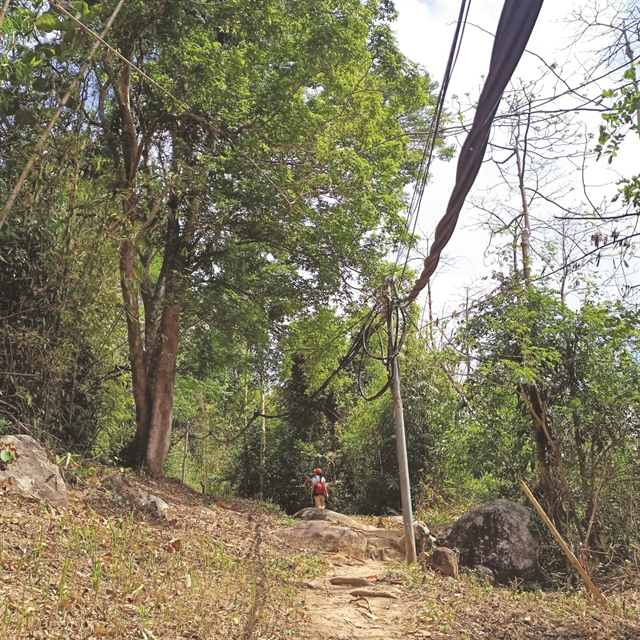Enveloped by lush greenery, Chứa Chan is adorned with many cliffs, creating a mesmerising panorama for adventure-seekers and nature enthusiasts alike.

A visitor at the top of Chứa Chan Mountain. — Photo gody.vn
Lâm Giang
Located in the southeastern province of Đồng Nai, Chứa Chan Mountain boasts a breathtaking landscape that draws visitors from far and wide.
Towering above sea level at 837 metres, this majestic peak is the second-highest in the region, trailing only Bà Đen Mountain in Tây Ninh Province.
Enveloped by lush greenery, Chứa Chan is adorned with many cliffs, creating a mesmerising panorama for adventure seekers and nature enthusiasts alike.
Many young people flock to this destination, eager to indulge in mountain climbing, trekking, and exploring the revered Bửu Quang Pagoda - also known as Gia Lào Pagoda - where they pay their respects by offering incense.
Chứa Chan Mountain is in the town of Gia Ray, in Đồng Nai's Xuân Lộc District, over 100km away from the bustling metropolis of Hồ Chí Minh City.
Mt Chứa Chan, the "roof" of Đồng Nai, has an arc shape of three consecutive peaks covering an area of 1,400ha. In 2012, the Ministry of Culture, Sports, and Tourism ranked the mountain as a national scenic heritage.
The mountain is the origin of four streams: Gia Ui stream (flowing to the east), Gia Miên (to the west ), Gia Liêu (to the south), and Gia Lào (to the north), with cool water all year round. In the rock holes, the underground water springs up and gathers, which the locals call Tiên Well.
There are four pagodas on the mountain. Bửu Quang is at the highest position. The pagoda nestles against a cliff with an altitude of over 660m. It was opened in the early twentieth century with the tectonics of a rock cave.

A corner of Bửu Quang Pagoda. — Photo vn.alongwalker.co
Its architecture is simple, but it looks solemn, and has become a pilgrimage site for many Buddhists in the country.
From the foot of the mountain, we prepared items such as walking sticks, sport shoes, and wide-brimmed hats to take a 3.2km long trek to conquer the mountain.
While climbing the steps to the pagoda, we had the opportunity to enjoy the beautiful mountainous view on both sides.
On the way to the pagoda, there is a place visited by many pilgrims associated with an interesting tree. The banyan tree is over 12m tall and has three large roots bunched together to form a high top. Various mysterious stories have made many people curious and stop here.
The pagoda has a guest house, and the kitchen is behind the main hall, always available for pilgrims to cook for themselves when visiting this site.
In particular, in the rock crevices behind the pagoda, a stream of cool water flows all year round. There is a small shrimp species living here, so it is called Tôm (shrimp) Stream. Legend has it that anyone who visits the pagoda with a sincere heart will catch this small shrimp and bring it home with the wish that the best things will come.
Currently, there is a cable car rout to the pagoda. Visitors can take cable car or walk to enjoy the scenery from above, depending on their ability and preferences.

Visitors will reach the top of the mountain, following the trail with electric poles. — Photo gody.vn
Climbing mountain
Young people who want to conquer the top of Chứa Chan Mountain, can choose two main routes.
Climbing following the trail with the electric poles to the mountain. It is many people's favourite route because it is intimate and close to nature.
After arriving at Gia Ray Town, following Ngô Quyền Street to Hoàng Đình Thương Street, you turn left, go to the end of the road, meet Ông Đồn T-junction, turn right about 200m to reach this road.
You must follow the trail and look at the poles and power lines. There are about 125 poles here, but the numbering starts from 20, so you only need to pay attention to the No 145 to reach the top of the mountain.
The climbing route is quite steep, with many large rock caves and dense forests, requiring the explorers to have some experience.
It takes about three hours to reach the top of the mountain.
The mountaintop area is relatively flat, spacious, and convenient for camping. On the top of the mountain is the SK11 information station; visitors can ask for assistance with rest stop.
The second way to the top of Chứa Chan is to climb along the pagoda road.
After climbing the steps to go up to Bửu Quang Pagoda, you walk about 30 minutes to the top of the mountain.
However, going from the pagoda to the mountain peak is quite difficult and dangerous because there are reeds, luxuriant bamboo forests and turns that can make you lose your way. Remember to visit the shacks of locals to ask for directions if you get lost.

Camping on the top of Chứa Chan Mountain. — Photo hoileonui.com
After completing the climb to Chứa Chan Mountain, you also enjoy delicious food at the foot of the mountain. Hotpot and grilled dishes of goat meat are famous specialties in this mountainous region, which many tourists choose. VNS